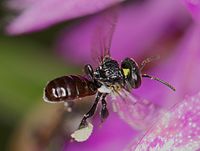
Photo from wikipedia
Social insects are instructive models for understanding the association between investment in brain size and behavioral variability because they show a relatively simple nervous system associated with a large set… Click to show full abstract
Social insects are instructive models for understanding the association between investment in brain size and behavioral variability because they show a relatively simple nervous system associated with a large set of complex behaviors. In the jataí stingless bee (Tetragonisca angustula), division of labor relies both on age and body size differences among workers. When young, both minors and soldiers engage in intranidal tasks and move to extranidal tasks as they age. Minors switch to foraging activities, while soldiers take over defensive roles. Nest defense performed by soldiers includes two different tasks: (1) hovering around the nest entrance for the detection and interception of heterospecific bees (a task relying mostly on vision) and (2) standing at the nest entrance tube for inspection of returning foragers and discrimination against conspecific non‐nestmates based on olfactory cues. Here, using different‐sized individuals (minors and soldiers) as well as same‐sized individuals (hovering and standing soldiers) performing distinct tasks, we investigated the effects of both morphological and behavioral variability on brain size. We found a negative allometric growth between brain size and body size across jataí workers, meaning that minors had relatively larger brains than soldiers. Between soldier types, we found that hovering soldiers had larger brain compartments related to visual processing (the optic lobes) and learning (the mushroom bodies). Brain size differences between jataí soldiers thus correspond to behavioral specialization in defense (i.e., vision for hovering soldiers) and illustrate a functional neuroplasticity underpinning division of labor.
Journal Title: Journal of Comparative Neurology
Year Published: 2022
Link to full text (if available)
Share on Social Media: Sign Up to like & get
recommendations!